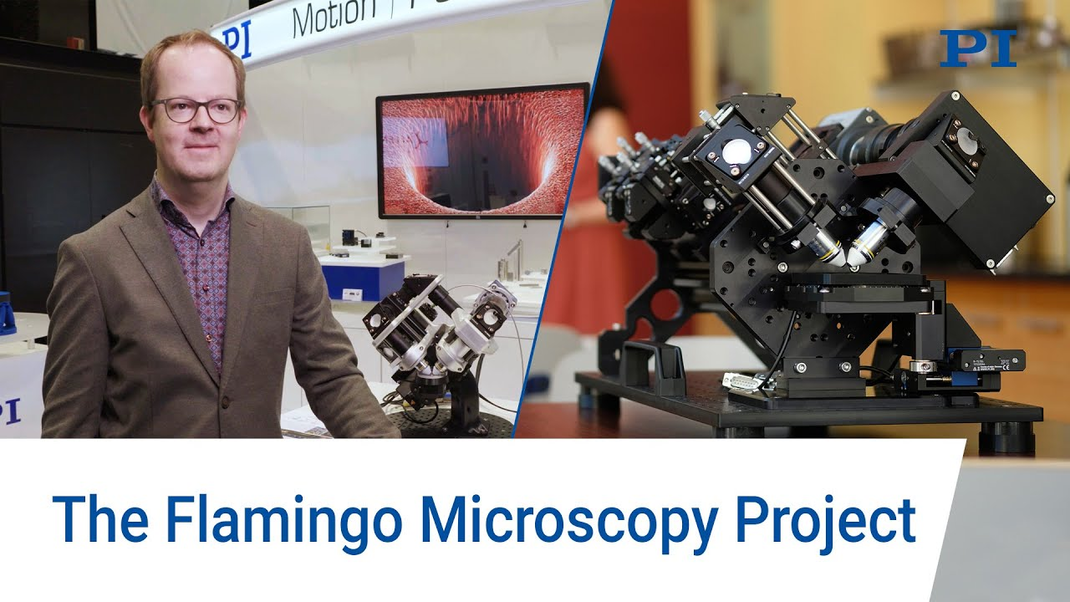Making Groundbreaking Technology Freely Available
Microscopy is one of the technologies that is constantly reinventing itself. The first microscopes from the early 17th century were very simple in design, but countless developments have steadily increased their performance. Whether anti-reflection coatings that ensure less scattered light and images with a much higher contrast, new lens materials that reduce color dispersion and allow more complex optics, the groundbreaking theories of Ernst Abbe, who was once the first to calculate how to increase resolution, or the super-resolution techniques for fluorescent samples and lightsheet microscopy with significantly reduced light scattering through the sample. This list could be extended indefinitely and up to now, the innovations in microscopy are the driving force behind new findings in many disciplines.
In addition to further developments by the major instrument manufacturers, it is often the ingenious researchers at universities and institutes who require very special microscope designs for their experiments and build these themselves in their own development. Example for this are the Flamingo Light Sheet Microscope from Huisken Labs at the Morgridge Institute for Research (Madison, WI) or IsoView, also a light sheet microscope - developed by Philip Keller and his research team at the Janelia Research Campus of the Howard Hughes Medical Institute in Ashburn (Virginia). The GATTAscope, which uses TIRF technology in conjunction with STORM techniques is also one of those in-house developments. The resulting designs are often shared on the Internet and a global community has developed that uses identical microscopes in order to compare the scientific results of a research group with their own work.
Not only application knowledge and research results but also the details of these setups, including all components used, are exchanged globally in the communities. In addition to information on laser and optic manufacturers, cameras and software the focus is also on positioning systems, their underlying drive technologies and control options. Each experiment makes its own demands on the microscope design and the positioning systems used in it.
Groundbreaking Approach
Open-Source Microscopy Supports Cutting-Edge Discoveries
Drive Concepts
PI provides a variety of different drive types in order to fulfill the various requirements on travel range, dynamics, precision, size, etc. These can be divided roughly into two classes: Piezo-based drives and electric motors.
Piezo Actuators and Motors
PI uses piezoceramic components developed in-house for its piezo-based drives. These are the fully ceramic isolated PICMA® piezo actuators in the PIFOC objective scanners. The actuators are levered by flexure guides and allow travel ranges of up to 460 µm and new developments will even allow travel ranges of up to 800 µm. Furthermore, they are characterized by a significantly faster response and lifetime than motor drives - up to 100 billion cycles without failure have been proven. The PIHera linear axes based on the same principle are used for example, in the IsoView light sheet microscope for moving the objective. Integrated, capacitive sensors measure with subnanometer resolution without contacting. They offer excellent linearity of motion, long-term stability, and a bandwidth in the kHz range.
PILine® Ultrasonic Motors are also based on piezo technology. They enable linear motion with virtually any travel range and rotary motion. The very flat drives can be easily integrated mechanically and reach a typical maximum velocity of 100 mm/s with a bidirectional position repeatability in the range of ±500 nm. A special feature of these drives is the holding force when at rest and when switched off. A position that has been reached is kept mechanically stable without additional energy and heat input. Applications with a low duty cycle that are battery-powered or heat-sensitive benefit from these characteristics. PI offers several standardized XY stages based on ultrasonic technology. Single-axis linear drives and rotary drives are also available. For example, the U-628 rotation platform plays a central role in the Flamingo light sheet microscope.
Motorized Drives
In the field of electromotive drives, PI offers a large selection of spindle-driven and direct-driven linear stages, as well as servo and stepper motor variants. For example, the compact L-505 linear stage with folded drive is used in the Flamingo LSFM. It is used to move the sample chamber along the optical axis. It serves to create Z-stacks that allow the sample to be displayed in its entirety in three dimensions.
Electromotive linear drives can be stacked if required and can also be combined with goniometers to achieve positioning in several degrees of freedom. The technology portfolio is supplemented by the very dynamic voice coil drives. The latter are used for example, in Z-positioners for travel ranges of several millimeters.
Controller Technology and ID Chip
Together with the mechanical properties of the platform, the possibility of control also plays a decisive role in its use. Controllers developed by PI with SW interfaces to all common development environments enable precise control of the drive - depending on the requirements of the respective experiment. And there's more: Although it is usual that one controller is able to control several axes of motion simultaneously, PI's controllers can also do this across technologies. For example, axes driven by stepper motors and ultrasonic motors can be operated via one controller. This allows coordinated motion and the systems behave much more dynamically. The standardized 'General Command Set' (GCS) that is the same for all PI controllers also supports this. The General Command Set (GCS) ensures maximum compatibility within PI's positioning systems, irrespective of the drive principle in use, and also makes updating and upgrading easier. This makes starting, operating, and programming much easier: Various positioning systems can be operated at the same time and new systems can be integrated with minimal programming effort. GCS also simplifies the development of customer-specific applications considerably.
The ID chip also allows easy use of PI positioners. It stores the calibration data of sensors and actuators. When installing for the first time, the controller reads this data and it is no longer necessary for time-consuming and labor-intensive parameterization by the user.
The Agony of Choice: Which Positioner Suits the Application?
The question which positioning system is suitable for the task at hand cannot be answered in general terms. The following factors are decisive for development:
- What is the travel range?
- How accurate must positioning of the sample or optics be?
- What are my requirements for the dynamics?
- How much space is required or available?
- What other constraints do I have to consider?
For example: Temperature range, atmosphere (pressure, humidity), magnetism...
The wide range of drive technologies and the positioning systems based on them allows PI to find a suitable solution for practically all applications. Specially trained application experts provide support in the selection process.
A Myriad of Application Examples
The example of the rotation platform for the Flamingo light sheet microscope indicates the numerous open source microscopy projects where diverse motion and positioning systems from PI are used. Professor Jan Huisken explains why he has chosen PI for the Flamingo Project: "By partnering with PI, we can make these instruments more precise and use the best micropositioning for these instruments, for these high-resolution microscopes [...]. We have been working with PI for a long time and have been using their stages for just as long [...] and we are very satisfied with their performance and decided to use them in the Flamingo as well." You can find the complete Interview with Professor Huisken here:
In addition to the previously mentioned Flamingo, Iso-View and Gattascope projects, PI systems are also used in the 4PI project of Prof. Joerg Bewersdorf, Yale University, MesoSPIM of PhD Fabian F. Vogt and Prof. Fritjof Helmchen of the University of Zurich, the OpenScopes project at the Imperial College of London as well as in many other projects.


